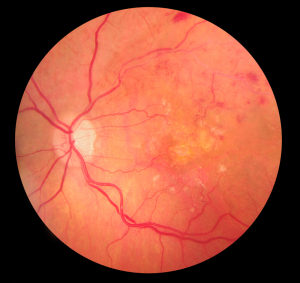Introduction
Patients who develop central retinal vein occlusion are usually older and have often one of these conditions: high blood pressure, glaucoma, diabetes, a medical condition associated with thickened blood (where blood viscosity is increased).
Signs and symptoms
Central retinal vein occlusion presents with impaired vision in one eye, usually with no pain or other symptoms. Visual loss is usually slow, but can be sudden. Occasionally it presents with a painful blind eye, light sensitivity and redness of the eye.
Diagnostic tests
On examination of the eye (fundoscopy) the specialist sees engorged veins in the back of the eye with veins that are winding more than is normal.
In addition there are areas where blood is leaking resulting in several retinal hemorrhages (thanks to www.bethesdaretina.com for this image). Perfusion tests with fluorescein angiography establish the state of blood circulation of the retina and can depict areas of blood leakage into the retina.
Treatment
Treatment depends on the underlying condition, which is being treated.
Generally, there is a consensus that those patients who have normal retinal perfusion on fluorescein angiography do much better on the longterm. Otherwise there is no consensus, which treatment would give the best results.
Photocoagulation all over the retina can be used to prevent further bleeding. Each case has to be treated individually depending on the findings. Glaucoma can develop as a result of the scarring and also as a result of new blood vessel development (“neovascular glaucoma”).
References:
1. The Merck Manual (thanks to www.merckmanuals.com for this link): Retinal eye disorders.
2. Eye conditions: http://www.stlukeseye.com/Conditions/
3. Ferri: Ferri’s Clinical Advisor: Instant Diagnosis and Treatment, 2004 ed., Copyright © 2004 Mosby, Inc.
4. Rakel: Conn’s Current Therapy 2004, 56th ed., Copyright © 2004 Elsevier







